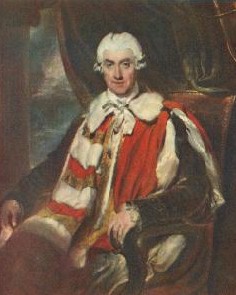Related Research Articles

Thomas Thynne, 1st Marquess of Bath, KG, PC, of Longleat in Wiltshire, was a British politician who held office under King George III. He served as Southern Secretary, Northern Secretary and Lord Lieutenant of Ireland. Between 1751 and 1789, he was known as the 3rd Viscount Weymouth. He is possibly best known for his role in the Falklands Crisis of 1770.

Charles Wyndham, 2nd Earl of Egremont, PC, of Orchard Wyndham in Somerset, Petworth House in Sussex, and of Egremont House in Mayfair, London, was a British statesman who served as Secretary of State for the Southern Department from 1761 to 1763.
The Peerage of the United Kingdom is one of the five Peerages in the United Kingdom. It comprises most peerages created in the United Kingdom of Great Britain and Ireland after the Acts of Union in 1801, when it replaced the Peerage of Great Britain. New peers continued to be created in the Peerage of Ireland until 1898

Marquess of Bath is a title in the Peerage of Great Britain. It was created in 1789 for Thomas Thynne, 3rd Viscount Weymouth. The Marquess holds the subsidiary titles Baron Thynne, of Warminster in the County of Wiltshire, and Viscount Weymouth, both created in 1682 in the Peerage of England. He is also a baronet in the Baronetage of England.
This is a list of people who have served as Lord Lieutenant of Surrey. Since 1737, all Lords Lieutenant have also been Custos Rotulorum of Surrey.
This is a list of people who have served as Lord Lieutenant of Hampshire. Since 1688, all the Lords Lieutenant have also been Custos Rotulorum of Hampshire. From 1889 until 1959, the administrative county was named the County of Southampton.

The Groom of the Stool was the most intimate of an English monarch's courtiers, responsible for assisting the king in excretion and hygiene.
This is an incomplete list of people who have served as Lord Lieutenant of Somerset. Since 1714, all Lord Lieutenants have also been Custos Rotulorum of Somerset.

Thomas Thynne, 2nd Viscount Weymouth of Longleat House in Wiltshire was an English peer, descended from Sir John Thynne (c.1515-1580) builder of Longleat.

Brooks's is a gentlemen's club in St James's Street, London. It is one of the oldest and most exclusive gentlemen's clubs in the world.
References
- ↑ "Lords of the Bedchamber". Glued Ideas. Retrieved 17 June 2019.
- 1 2 3 R. O. Bucholz, "The bedchamber: Gentlemen of the Bedchamber", Office-Holders in Modern Britain: Volume 11 (revised): Court Officers, 1660-1837 (2006), pp. 14–19 accessed 13 October 2018.
- ↑ G. Dyfnallt Owen, HMC 75 Downshire, vol. 5 (London: HMSO, 1995), p. 202 no. 423.
- ↑ Taliaferro, Henry (1996). "Thomas Smith of Fairfax County, Virginia". The Virginia Genealogist. 40 (Q1 1996): Page 3. Retrieved 5 July 2019.
- ↑ Gillan, Caroline (2018). Lord Bute and Eighteenth-Century Science and Patronage (PDF). PhD degree, Department of History, National University of Ireland. p. 1.
- ↑ Spain, Jonathan (2004). "Keppel, William Anne, second earl of Albemarle". Oxford Dictionary of National Biography (Online ed.). Oxford University Press. doi:10.1093/ref:odnb/15443.(Subscription or UK public library membership required.)
- ↑ "STANHOPE, Philip Dormer, Lord Stanhope (1694-1773)". History of parliament Trust. Retrieved 4 April 2019.
- ↑ "PAGET, Thomas Catesby, Lord Paget (1689-1742)". History of Parliament Trust. Retrieved 4 April 2019.
- ↑ "MANNERS, Lord William (1697-1772), of Croxton Park, Lincs". History of Parliament Trust. Retrieved 4 April 2019.
- ↑ "COVENTRY, George William, Visct. Deerhurst (1722-1809), of Croome Court, Worcs". History of Parliament Trust. Retrieved 4 April 2019.
- ↑ "HOBART, John, Lord Hobart (1723-93), of Blickling, Norf". History of Parliament Trust. Retrieved 4 April 2019.
- ↑ "ST. LEGER, Arthur Mohun, 3rd Visct. Doneraile [I] (1718-50)". History of Parliament Trust. Retrieved 4 April 2019.
- ↑ "MANNERS SUTTON, Lord Robert (1722-62), of Kelham, Notts". History of Parliament Trust. Retrieved 4 April 2019.
- ↑ "BERTIE, Lord Robert (1721-82), of Chislehurst, Kent". History of Parliament Trust. Retrieved 4 April 2019.
- ↑ "LEE, George Henry, Visct. Quarendon (1718-72), of Quarrendon, Bucks., Ditchley Park and Spelsbury, Oxon". History of Parliament Trust. Retrieved 5 April 2019.
- ↑ "HOBART, John, Lord Hobart (1723-93), of Blickling, Norf". History of Parliament Trust. Retrieved 5 April 2019.
- ↑ "HARLEY, Edward, Lord Harley (1726-90)". History of Parliament Trust. Retrieved 4 April 2019.
- ↑ "BERKELEY, Norborne (?1717-70), of Stoke Gifford, near Bristol, Glos". History of Parliament Trust. Retrieved 4 April 2019.
- ↑ "FINCH, Heneage, Lord Guernsey (1751-1812)". History of Parliament Trust. Retrieved 4 April 2019.
- ↑ "PITT, George (1721-1803), of Strathfieldsaye, Hants". History of Parliament Trust. Retrieved 4 April 2019.
- ↑ "TOWNSHEND, Hon. John Thomas (1764-1831)". History of Parliament Trust. Retrieved 4 April 2019.
- ↑ "PITT, George (1751-1828), of Strathfieldsaye, Hants". History of Parliament Trust. Retrieved 4 April 2019.
- ↑ "LAMB, Peniston (1745-1828), of Brocket Hall, Herts. and Melbourne Hall, Derbys". History of Parliament Trust. Retrieved 4 April 2019.
- ↑ A Political Index to the Histories of Great Britain & Ireland
- ↑ The Edinburgh Gazette, 3 August 1830.
- ↑ The London Gazette, 10 August 1830.
- ↑ The Edinburgh Gazette, 18 March 1831.
- ↑ The London Gazette, 26 August 1831.
- ↑ The London Gazette, 7 October 1831.
- ↑ The London Gazette, 25 May 1832.
- ↑ The London Gazette, 27 November 1832.
- ↑ "CAVENDISH, see Henry Manners, Henry Manners, 3rd Bar. Waterpark [I] (1793-1863), of Doveridge Hall, Derbys". History of Parliament Trust. Retrieved 4 April 2019.
- ↑ Edinburgh Gazette
- ↑ Edinburgh Gazette Edinburgh Gazette
- ↑ Edinburgh Gazette
- ↑ Edinburgh Gazette
- ↑ Velde, François R. (2004-08-24). "La Maison du Roi (The King's Household)". French Heraldry and Related Topics. Heraldica.org. Retrieved 2007-11-22.